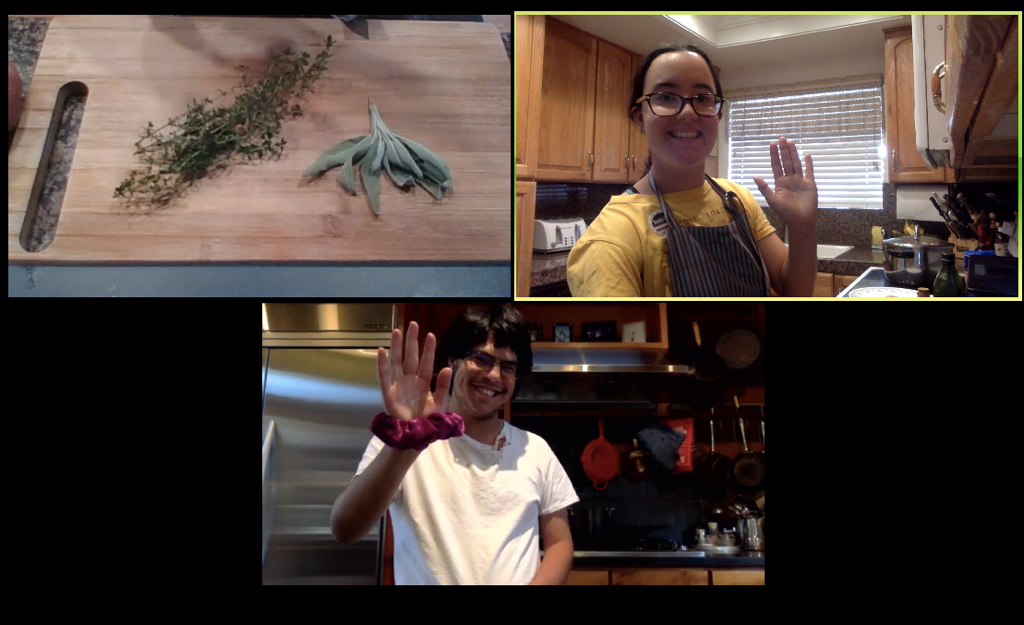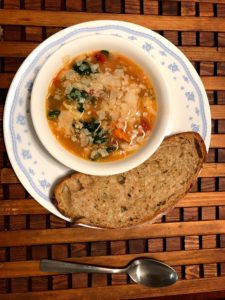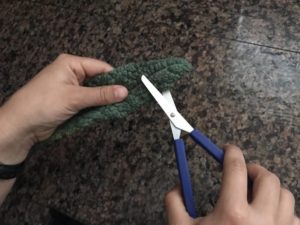Knifeless Cutting Techniques
May 5, 2021

With spring in full bloom, now is a wonderful time to enjoy all the fresh fruits and veggies the season has to offer! In past Adaptive Cooking Tips articles, I’ve given tips and suggested tools for preparing produce and practicing safe knife skills. But using a knife is not the only way to get your fruit or vegetable into smaller, easy-to-eat pieces. There are different ways you can cut produce without using a knife.
Why Learn Knifeless Food Preparation?
As I’ve mentioned in my past blog post article on safe knife skills, knives are sharp tools that you need practice and strong coordination to use. For various reasons, some folks may not able to use a knife easily or comfortably. They may not have use of both hands because of tremors or motor skills challenges which make cutting difficult. Thankfully, knives are not the only way to “cut” and prepare food for cooking.
Tearing or Ripping Food into Smaller Pieces
One of the simplest ways to get food into smaller pieces doesn’t even require a special tool – you just need your hands! Tearing or ripping your food into smaller pieces is one of the easiest ways to prepare some produce. Foods that are excellent for the tearing method include any kind of leafy green, like chard, kale, or most fresh herbs. To practice the tearing method:
- Put the greens you are preparing to tear on a clean surface and have an empty bowl next to them.
- Pick a leaf to start with and use both hands to carefully tear the leaf into two pieces. (Don’t squeeze the leaf too hard, or you might get mushy veggies.)
- Take the two smaller pieces of the leaf and carefully rip them into still smaller pieces. Repeat until the leaf pieces are small enough to eat, but still easy to pierce with a fork.
- When you’ve finished ripping the leaf into smaller pieces, place the pieces in the bowl and repeat the same process with each leaf until all the leaves are in smaller pieces in the bowl.
Scissors or Loop Scissors
Another way to get food into bite-size pieces without using a knife is to use kitchen scissors. This also works well with greens and herbs, as well as long, slender veggies such as asparagus or scallions. For some folks, kitchen scissors may be awkward or uncomfortable to use. In that case, these adaptive loop scissors can be a great alternative.
To chop veggies with loop scissors:
- Hold the scissors in your dominant hand, which is the hand you use to write or to hold a fork or spoon. Place your thumb on the outside of the loop handle and place your other fingers on the other side of the loop handle.
- Use your non-dominant hand to hold the vegetable in between the open blades of the scissors where you intend to cut it. Keep your fingers clear of the blades!
- Using your dominant hand, squeeze the loop scissors together in a pinching motion. This will cut the vegetable.
- Repeat until your produce is in bite-sized pieces.
Crinkle Cutter
A crinkle cutter is another knife-alternative that can put a fancy spin on the way your produce is cut. This tool was actually introduced to us by a participant named Katie, during one of our Skills Building Cooking Classes. Katie showed us how the crinkle cutter worked well for her by allowing her to cut vegetables in an easy, push-down motion. She even inspired another participant, Josh, to purchase the crinkle cutter! Josh was so excited about the new tool, he shared it during a recent Popcorn Chat class, saying his favorite recipe to use the crinkle cutter is when making nachos. Crinkle cutters are a good knife alternative for those who may be uncomfortable using knives, as it keeps your fingers away from the blade. It can also help folks who have tremors in their hands as it can be used with one hand instead of two. Crinkle cutters work especially well with small, harder vegetables, such as carrots, radishes, or zucchini.
To use the Crinkle Cutter:
- Place your produce to be cut on a clean cutting board
- Using your dominant hand, grasp the crinkle cutter at the top (the non-blade part). Have your thumb on one flat side of the handle and your fingers on the other flat side of the handle. Keep your fingers off the metal blade.
- Hold your produce against cutting board surface with non-dominant hand.
- Place blade of crinkle cutter into produce where you want to cut it. Press down with even force.
- Repeat until your vegetable is cut into the correct-size pieces.
Pull Chopper
 The pull chopper is yet another knife-alternative that makes cutting and dicing produce easy. Scott, a participant in our Simple Meals Cooking Class, recently used his pull chopper while making tomato soup. Scott enjoys the pull chopper for its ease in cutting onions and carrots. One pull of the pull chopper allows ingredients to be rough chopped, two pulls dices the ingredients, and three pulls minces them.
The pull chopper is yet another knife-alternative that makes cutting and dicing produce easy. Scott, a participant in our Simple Meals Cooking Class, recently used his pull chopper while making tomato soup. Scott enjoys the pull chopper for its ease in cutting onions and carrots. One pull of the pull chopper allows ingredients to be rough chopped, two pulls dices the ingredients, and three pulls minces them.
To use a Pull Chopper:
- Remove the lid of the pull chopper and set aside. Ensure the blade is placed in the chopping bowl.
- Add whatever produce ingredients you would like chopped to the bowl. Replace the lid.
- Pull on the pull string on the top of the lid and watch your ingredients be chopped. Repeat pulling until your ingredients are cut to your liking.
Simple Knifeless Salad
With so many knife-alternatives to choose from, I thought it would be helpful to describe a simple recipe that uses all of the options mentioned above. Keep in mind, this is just to demonstrate where each tool might work best for different ingredients in a salad. You can choose the best tool for you to find success in your cooking!
Salad Ingredients
1 bunch of Kale, washed and dried
1-2 Oranges
2-3 Radishes, rinsed (will be easier to cut with the leaves and stem still on)
¼ Cup Pecans or Walnuts (Sunflower seeds are a good substitution if you have nut allergies.)
Dressing Ingredients
½ Cup Olive Oil
3 Tablespoons Vinegar
1 Tablespoon Mustard
1 Tablespoon Maple Syrup or Honey
Salt & Pepper (to taste)
 “Rip and tear” the kale leaves. You want the torn leaves to be about the size of half a post-it note. Kale is an especially good veggie to prep with your hands, as when you are done tearing it to pieces, you can massage the kale so it is easier to eat. Massage the kale by gently rubbing it between your fingers, and place it in a bowl.
“Rip and tear” the kale leaves. You want the torn leaves to be about the size of half a post-it note. Kale is an especially good veggie to prep with your hands, as when you are done tearing it to pieces, you can massage the kale so it is easier to eat. Massage the kale by gently rubbing it between your fingers, and place it in a bowl.- Peel and snip the orange pieces. Peel your orange. Now use your hands to pull apart the sections of the orange from one another. When all the sections are separated, use scissors or loop scissors to cut each section into three equal pieces (the two tips of the orange section and the middle piece). Add the orange pieces to the bowl.
- Crinkle cut the radish. Place a radish against the cutting board, and hold it by its stem. Using your dominant hand, use the crinkle cutter to press down into the radish to cut the radish into slices, starting from the bottom of the radish and moving up towards the stem. Repeat until all the radishes are sliced. Place your radish slices in the salad bowl.
- Pull-chop the nuts. Place the pecans or walnuts into the pull chopper, ensuring the blade is already installed (the pull chopper may not be necessary with sunflower seeds). Place the lid on top of the pull chopper. Pull the string. Repeat as necessary until nuts are chopped to desired size. Add to the salad bowl.
- Make the dressing. Pour the dressing ingredients into a jar with a lid. Screw the lid on tight and shake until the ingredients are well mixed. You could also do this by adding the ingredients to a bowl and stirring them with a fork or whisk. Add your finished dressing to your salad bowl. Enjoy your healthy, knifeless-prepared salad!
Story by: Abby Lourenco, Garden and Cooking Class Teacher
Contributing Writer: Kaitlyn Kuehn, Writer

